L.Opdyke French Aeroplanes Before the Great War (Schiffer)
Deleted by request of (c)Schiffer Publishing
Antoinette IV: The next design, resembling somewhat the Gastambide-Mengin, rolled out at Issy in November 1908. This single machine was radically modified over a short period of time: changes could have been made even within a few hours, making photographic sequencing nearly impossible.
All versions shared the long triangular-sectioned fuselage of the later Antoinettes, similar wide trapezoidal wings, centrally-mounted undercarriage and triangular sail-like tail surfaces; No IV was the only model with ailerons, the rest having warping wings.
The following brief sketch of the design progression of the first No IV is an estimation; some of the features described here overlapped across several changes. The first undercarriage consisted of 2 wheels on what looked like enlarged bicycle forks, in tandem; triangular ailerons hung loosely, with loose fabric for the trailing edges. The rudder was a rectangular panel between the forward triangular fin and a trailing triangular fin, and the elevator corresponded to it, without the trailing surface. Then the undercarriage was reversed with a single trailing wheel set into the rear of a long skid girder which had a small wheel set out in front of the tip. The rectangular elevator was fixed, and a triangular surface was hinged behind it. The name Antoinette was painted on the sides of the radiators. Further changes included a roller set into the front of the skid, the rectangular rudder taken out and the familiar pair of triangular rudders substituted, the familiar spoked control wheels appeared on the sides of the cockpit, the nose was covered, and small wheels were fixed to the wingtip skids.
Then the bracing mast was set right above the undercarriage strut; the familiar long diagonal skid replaced the horizontal girder; and a close-set pair of wheels were fitted on a crossaxle. Then the fuselage, at least, must have been re-covered, since diagonal tapes showed between the diagonal fuselage bracing, giving a series of diamond patterns; a small wheel was set the tip of the skid. A curved wooden fairing was added to the bow and another fastened to the forward undercarriage brace. Latham attempted the Channel crossing in it when the fuselage veneer extended to the rear of the side radiators, the diagonal nose-wheel strut had been re-set, and the trailing wing skids had been taken off. The machine was destroyed when it crashed in the water.
At Reims in August 1909 another Antoinette, very similar to Latham's No IV, was entered with the number 13 painted on the sides. It differed from Latham's in having a second horizontal brace in the undercarriage, and lacked the little nosewheel on the skid. In the Champagne meet later the same year, this machine appeared again, with a second diagonal brace crossing the skid, now fitted once more with the nosewheel.
Ferber had designed the controls, consisting first of a left-side-mounted wheel for ailerons and rudder, a right-side-mounted wheel for elevator, 2 small wheels in front of the pilot for engine controls, and a foot-pedal with the ignition switch. Revised, the controls were similar, except that the foot-pedal now controlled the rudder. Levavasseur was said to have been asked why he retained such a complicated system, and he replied that flying was not simple, either. But his machines proved very stable and easy to fly, in spite of his control system.
The wing plan was of the type known as 6:3:2 (each panel had a 6-meter span, a 3-meter chord at the root, and 2-meter chord at the tip). The dimensions of the machine remained generally unchanged during its lifetime; in August 1909 they were described as follows:
(Span: 12.8 m; airfoil symmetrical front and back, as on the Antoinette I; angle of attack: 4°; length: 12 m; wing area: 34 sqm; empty weight: 460 kg; 50 hp Antoinette V8, with a propeller similar to that on Antoinette I)
After Antoinette IV was completed and before it was sent to the Channel, at least 4 other Antoinettes had been built, Nos V, VI, VII, and VIII, the latter flying in August 1909. Little is known about Nos V, VI, and VIII. Since Nos IV and VII were progressively retrofitted with the latest improvements, it is reasonable to suppose the same occurred with the other 3, unless they were abandoned too early for this process. Nos V and VI were similar to the first versions of No IV.
Antoinette V: It was built for Demanest with more aluminum parts, especially in the wing, than were used in No IV It had trapezoidal ailerons, closely-paired wheels at the rear of the heavy girder skid with a front-mounted roller, no forward under-fin, and a curved cut-out at each wing-root.
(Span: 12.5 m; length: 10.8 m)
Antoinette VI: This one was built for Captain Burgeat, at first with ailerons. These were later removed and replaced by a wing-warping system which proved more effective and which was used in No VII. With Levavasseur's system, the front spar was fixed and the rear one could pivot up and down. There was a control wheel on the right side as on all Antoinettes, but a second one was mounted like a steering wheel in front of the pilot, with a cushion between him and it.
Журнал Flight
Flight, January 9, 1909
THE FIRST PARIS AERONAUTICAL SALON.
"Antoinette"
Monoplane built and engined by the Soc. Antoinette. It has, like the " Bleriot No. 9," a particularly light, speedy appearance, and is not unlike a huge dragon-fly when viewed from above. The long V-section girder frame, resembling a racing skiff, enhances its sporting effect, and suggests that the type might become very popular if ultimately proved to be successful. Part of the frame is filled in by the condenser-tubes belonging to the Antoinette installation, as described elsewhere. At the rear is the rudder and the elevator; both are small triangular surfaces, and the former is placed immediately above the latter. They also both form extensions of fixed triangular planes forming a cross-tail.
Flight, January 23, 1909
THE FIRST PARIS AERONAUTICAL SALON.
Antoinette.
The manufacturers are specially building this year, for aeroplanes, a 50-h.p. installation which is the same as is used in their own monoplane. It is peculiar for the system of "steam-cooling" that has been adopted ; the water being allowed to boil in the jackets but being subsequently condensed. Twelve litres of water are carried in a small cylindrical tank and the water is pumped through the jackets, where it becomes more or less converted into steam by the time it returns to the tank; the jackets are electrolytically deposited in copper. Only the exhaust-valves are mechanically operated, the induction-valve is atmospheric.
On one end of the crank-shaft is the propeller, and on the other is the water-pump. The cam-shaft is driven by exposed gears and drives the fuel-pump which injectspetrol into each induction-valve chamber. The fuelpumps (there are two) have a variable throw by means of an eccentric mechanism. Accumulator ignition is employed in conjunction with a distributor mounted between the cam-shaft and fuel-pump.
Such water as is turned into steam passes automatically by expansion into a large aluminium tubular condenser, mounted longitudinally in the sides of the car frame, and is there converted into water again by air cooling. The condensed water is returned to the tank by a small belt-driven pump.
The eight cylinders are arranged V fashion upon an aluminium base-chamber, to which they are fastened by loose yokes at their flanges. They are made of forged steel, and are in one piece with their heads and valve-chambers.
Flight, April 3, 1909
Mr. Hubert Latham Progresses.
AT Chalons Camp Mr. Latham has been practicing with "Antoinette IV," and succeeded in flying over a kilom. Unfortunately an unexpected squall of wind drove him into the trees last week, resulting in the two wings being damaged. He hopes to add his name this week to the roll of winners of the "250 Metres Prize."
Flight, April 24, 1909.
The Antoinette Monoplanes.
THAT M. Rene Demanest has been able to do such remarkably good work on his Antoinette monoplane after only five lessons, demonstrates beyond all question the ease of manipulation of these "racers" of the air. After the fifth lesson, it will be remembered, M. Demanest secured the last of the 250 metre prizes of the Aero Club de France, and on the sixth occasion, a flight of 2 kiloms. at a height of 50 feet was accomplished.
On Monday Mr. Hubert Latham succeeded in making a splendid flight of 1,500 metres, including turning, at a height of about 15 metres, after which he came to earth quite easily.
Capt. Burgeat was also out on "Antoinette VI," and made several flights of 100 metres.
Flight, June 12, 1909.
MONOPLANE WORLD'S RECORDS REMARKABLE PROGRESS.
A FORTNIGHT ago we chronicled two records which had been made by Mr. Hubert Latham and M. Paul Tissandier respectively, and now we have to record a clean sweep made of those two records by Mr. Latham, who, by his latest performance, has placed himself second only to the Wright Brothers, and demonstrated in a wonderful manner the capabilities of that racing craft of the air - the monoplane type of machine.
After making his record flight of 37 1/2 mins. on the 22nd ult., Mr. Latham was practising on his machine at Chalons Camp continually, but attempted nothing but short flights until the 4th inst., when he again flew for 37 mins. at a height of between 20 and 25 metres. He displayed the utmost sang-froid while making this little trip, and during the second circuit, while passing over the heads of the spectators, he calmly took his hands off the steering wheel, rolled a cigarette and lighted it, thus creating a new record. He undoubtedly is the first man who has had the audacity to light and smoke a cigarette while in full flight.
On Saturday afternoon last, Mr. Hubert Latham once more brought out his "Antoinette" machine, and after making a couple of runs round the ground to see that everything was in order he rose into the air at 6.40 p.m. Rising steadily, he soon established himself at a height of about 15 metres, which was afterwards increased occasionally to 40 metres. He flew uninterruptedly, although the wind was blowing at a rate of 15 kiloms. an hour, for 1h. 7m. 37s., thus setting up a new world's record for monoplane flight and beating all French records for monoplanes or biplanes. Apart from the Wright Brothers, the records for long flights which have hitherto been made were held by Henry Farman, 20m. 19s. (July 6th, 1908); Delagrange, 29m.-54s. (August 6th, 1908); Paul Tissandier, 1h. 2m. (May 20th, 1909). Needless to say, the flight aroused the very greatest enthusiasm among the officers at the military camp, and by the time the flight was finished a very large crowd of spectators gathered, all wildly excited, despite the fact that the rain poured down during the last 20 mins. As soon as the monoplane came to earth, the young aviator was carried shoulder high to his shed by the crowd, and over one hundred officers at Mourmelon le Grand signed an official statement certifying to the length of the flight.
On Sunday evening last, Mr. Latham followed up this wonderful flight with another splendid one, when, having entered for, he carried off, with remarkable ease, the Ambroise Goupy Prize, which called for a flight of 5 kiloms. across country. Starting from the Chalons Camp at 7.52 p.m., Mr. Latham turned the head of "Antoinette IV" towards Cadenay and flew in a straight line over trees and houses for 5.9 kiloms. in 4m. 3 3/5 s. at a speed of about 50 miles an hour. Turning round without coming to earth, he regained his starting point - another record - without incident, and was wildly cheered by an immense crowd of onlookers, numbering close on 600 people. M. Ernest Zens was the official observer at the start, while M. Paul Tissandier was at the turning point.
A demonstration of the passenger-carrying possibilities of "Antoinette IV" was given by Mr. Latham on Monday evening, when he took up four of his friends for short flights. Capt. Burgeat, who also owns an Antoinette monoplane, was the first, and enjoyed a flight of 700 metres; Lieut. Charry was the second passenger; Mecanicien Cousin was the third, with a flight of 3 kiloms.; while the fourth was Mr. F. Hewartson, who had the longest flight of 11m. 57s, during which time about six miles were covered. During one of the turnings the wheel at the top of the left wing struck the ground, and a few minutes later the wheel fell off. Mr. Latham, on his attention being directed to it, stopped the motor and glided to the ground. During the last trip the wind was blowing in strong gusts, but Mr. Latham had complete control of the flyer.
A further exhibition of the gliding powers of the Antoinette monoplane was given on the following day, when Mr. Latham made two flights of 3 and 7 minutes respectively. At the conclusion of the second trip, when at a height of 10 metres, he switched off the ignition and glided to earth.
One result of these successful flights is to show that the art of navigating the air is by no means the exclusive property of a few men. Given properly designed machines, there is no lack of men with nerve and will who are capable of successfully manipulating them. The little band of aviators is ever widening, and it looks as if those who initiated the present heavier-than-air movement may be eclipsed by a newer and jounger school. Santos Dumont, Henry Farman, Delagrange and Bleriot are at any rate being out-distanced by the newcomers, who, once the ball is set rolling, realise its immense possibilities, although no doubt they in their turn will in all probability be eclipsed by others in due course.
In view of this magnificent flight with a monoplane and M. Tissandier's with a Wright biplane it would appear as if the Daily Mail prize of L1,000 for a cross-Channel flight should be within measurable distance of being won. It is, in fact, announced that Mr. Latham intends to make it his next objective, and to that end is making preparations at once. Perhaps his successes will spur on other experimenters to immediate action in the hope of doing even better.
Flight, July 17, 1909
THE CHANNEL FLIGHT.
WHATEVER interest may have attached to Mr. Latham's arrival at Sangatte, and to his subsequent proceedings at the old Channel Tunnel works, it bears no comparison with the sudden enthusiasm aroused by his giving the Daily Mail the required 24 hours' notice to fly, on Friday of last week. When it is actually realised that a man has seriously notified his intention of attempting to achieve a feat which has never before been accomplished in the history of the world and of doing so within 24 hours, the project comes down from the clouds with a run, and it is, indeed, no wonder that Calais and Dover should have been seething with excitement ever since. As luck would have it, our famous July weather made flight impossible, first on Friday, then on Saturday, Sunday, Monday, Tuesday and so on up to the time of going to press, when Mr. Latham is still on French soil and still continues to calmly scan the horizon between times when he is not in touch with his Antoinette machine or renewing his notice to fly.
Although up to the last moment hardly anything was done in the way of special preparation for the attempt, arrangements were very quickly elaborated once the project had taken definite shape, and one of the first preliminaries was the installation of a wireless service by the Marconi Co., who established communication between Sangatte and the roof of the Lord Warden Hotel at Dover. All being well, it was decided to land on the Rope Walk Meadow of Shakespeare Cliff. This spot was Mr. Latham's own choice, and except for the obstruction of two telegraph lines, it is fairly convenient.
Dover and its officials have given themselves up to preparing a suitable welcome, and Mr. Walter Emden, the Mayor, last Saturday postponed a trip to the Continent in order to be personally present. En route the British Motor Boat Club had made arrangements to patrol the course with speedy motor craft, but Mr. Latham, in expressing his thanks for the offer of their services, stated that he had made arrangements for this work to be done from the French side by the torpedo destroyers, "Le Harpon" and "Le Calaisien," the latter boat being equipped to haul the flyer on board should it fall into the sea. Mr. Perrin, the Secretary of the Aero Club of the United Kingdom, also offered the assistance of a similarly equipped tug from the English side if it was required.
Mr. Latham himself remains cool and collected amid his unique surroundings, and seems little affected by the undeniable excitement of the moment. Although his father was an Englishman, Mr. Latham, who is now 26 years of age, is a French citizen, and was born in Paris. He has served in the French army, and was for fifteen months at Baliol, Oxford. His first experience in aeronautics was obtained in 1905, when he accompanied M. Jacques Faure in a balloon trip across the Channel. This also was a record voyage, for in six hours he travelled from the Crystal Palace to the outskirts of Paris. He is a great advocate of high speed in flight, and intends to double the power of his flyer "after this Channel business is over."
On Tuesday morning of this week Mr. Latham decided upon a trial flight, merely to see that his machine was in proper order. There was no idea of attempting a crossing, although a tremendous crowd of spectators very quickly arrived on the scene directly there was a rumour to the effect that the flyer was about to be taken out for an airing. Wheeling the machine on to the highway, a start was made in the direction of Calais by running along the flat grass-land by the side of the road. This was one of the few convenient starting points in the vicinity, for although Mr. Latham has chosen a spot with natural facilities for working upon his machine - to wit, the Channel Tunnel works - his surroundings do not form altogether an ideal land aerodrome. Once he gets beyond the cliff and away to sea, however, that is a difficulty which will not bother him much. It was just after 8 o'clock when the flyer lifted, and rose steadily to an altitude of 30 ft. or so; it required a run of nearly a quarter of an hour to get off the ground.
For a duration of 6 1/2 minutes the flyer remained aloft, and then a descent was made in a cornfield, when some damage was done to the chassis on which the machine is supported. The cause of the mishap, which was in no way serious, was due to the unexpected rapidity of the descent; this was attributed by Mr. Latham to the failure of the wind, which was shielded below a certain altitude by surrounding obstructions. Repairs on the machine were immediately put in hand, and speedily finished in readiness for the favourable moment for starting. The insistent wind and rain, followed by fog, has continued with scarcely a break, and at the time of closing for press Mr. Latham had found it inexpedient to attempt the much-looked-forward-to flight.
Flight, July 21, 1909.
The Splendid Failure
AFTER more than a week of anxious waiting, the Channel flight has been attempted and lost. But what a splendid failure Mr. Latham made of his try. Everyone regrets that the precise task which he set out to accomplish is not achieved, and everyone sympathises with such a genuine sportsman in his misfortune. But after all is said and done, has not Mr. Latham's successful failure taught even more than would have been available from an uneventful success? Had he flown from Sangatte to Dover as had been hoped, and as he may yet do with the fates more favourable to his project, there would still have been that plaintive cry wailing beneath the general thunder of applause "Yes, but whatever would have happened had he fallen in the sea?"
It might have been years before anyone would have been found to come forward in willingness to demonstrate an answer to this question, for even apart from personal risk there is ever the prospect of losing a costly machine, and where logic fails to influence via the head, it is generally potent enough through the pocket. The chance which brought Mr. Latham down in mid-Channel, therefore, should, seeing that it did him no harm, be regarded from the standpoint of the old adage that "it's an ill wind that blows nobody good."
The question of being able to make a safe descent as far as the surface of the water, in the event of a mishap, was never really in doubt, since all aviators are agreed that, given sufficient height, it is practically always within the bounds of possibility to glide in the end even if the equilibrium of the machine has been temporarily upset in the beginning; that is, of course, always assuming that the pilot is a cool hand, and Mr. Latham is that and a good deal more. Taking the water at gliding speed - which by the way is at least that of the normal speed of flight - is an altogether different matter, and needed some such practical evidence as Mr. Latham gave on Monday, in order to supply any sort of clue as to what might be reasonably expected in a similary emergency. As to what might happen after the machine had settled on the water, there was also very considerable doubt, although we believe that Mr. Latham himself never expected anything else but that his flyer would float. There remained only one other point, and that was as to how far the pilot might hope to save himself should the machine sink, and this last we are exceedingly pleased Mr. Latham did not have to prove; he had done quite enough for one morning's work, and it was after all the least the fates could have done for him after he had braved their frown in such a sporting manner, to give him at the end the chance to smoke a cigarette in peace.
It is, of course, quite impossible to overrate the importance of the personal factor in an emergency of the kind which befell Mr. Latham. He was on the point of taking a photograph of his convoy, the torpedo destroyer "Harpon," as it steamed furiously through the waters nearly a thousand feet below, when he first heard his engine mis-fire. If in the whole gamut of human sensations there is anything more likely to bring one's heart into one's mouth than the sudden mis-firing of one's engine while aboard a flyer a thousand feet above the sea, we should like to know of it; it should come very near to paralysing the nerve centres, we should imagine. "Instantly I gave up any idea of photography" is Mr. Latham's first remark in commenting upon the incident.
Well, it needs a little getting used to, to appreciate the exact frame of mind which will permit of an interest in snapshots simultaneously with the necessity of paying attention to flight, so that perhaps after all it is only in keeping with the situation that Mr. Latham should have found it natural to explain that he did not finish taking the picture before he attended to anything else. In fact, one may even be permitted to regret, under the circumstances, that the photograph was not taken; it would have been such an extraordinarily interesting momento of the occasion.
"I examined all the electrical connections that were within my reach," continues Mr. Latham in the narrative he wrote for the Daily Mail. Could anything possibly give greater confidence in the future of the flyer than this simple statement? Here is a man who has such confidence in his machine that he is able, at critical moments like this, to set about trying to cure ignition troubles, forsooth, in mid-air. We can almost imagine that it would have needed no more than the slightest excuse for Mr. Latham to have set about and changed an ignition plug. But, as he explains, "I could hear that more than one of the eight cylinders were mis-firing." Affected by the recollection of the difficulty, Mr. Latham gives way at last to his first signs of feeling. "It was maddening, but I was helpless. Never before had the engine played me such a trick after so short a flight." Like all good sportsmen, Mr. Latham accepted the inevitable, but with the firm intention of making the best of that, too, and having "calculated that the torpedo boat destroyer was about a mile away" he glided down to the surface of the water, for, as he succinctly remarks, "There was nothing else to be done."
Describing his descent, Mr. Latham says, "I came down not in a series of short glides, but in one clean straight downward slope. My speed at the moment of impact was about 40 or 45 miles an hour. The machine was under perfect control during ascent; instead of diving into the sea at an angle I skimmed down so that I was able to make contact with the sea with the aeroplane practically in a horizontal position. It settled on the water and floated like a cork. I swung my feet up on to a cross bar to prevent them from getting wet. Then I took out my cigarette case, lit a cigarette, and waited for the torpedo destroyer to come up." Although Mr. Latham does not actually make the remark, we imagine it was merely an omission that he did not conclude the above sentence with his former delightful platitude, "There was nothing else to be done."
The gliding descent, the taking of the water in a horizontal attitude at a speed of 40 miles an hour, and the subsequent bouyancy of the Antoinette flyer, are all matters of the greatest possible importance, less, perhaps, on account of any immediate and direct application than because of their unique character. No man wants to lose his life in flying if he can help it, and even the best of swimmers, and we believe Mr. Latham is a master of this accomplishment, generally dislike getting wet within their clothes.
But there are bound to be many enthusiasts who aspire to the Channel crossing, and it is going to make all the difference in the world what machine becomes popular for this little journey, as to which affords the greatest security in the event of mishap. Even the best regulated of engines are apt to misfire, and if they follow this up by stopping off work altogether, as Mr. Latham's motor did, there is, as Mr. Latham expresses it, nothing else to be done save to descend upon the water with what ease and grace the pilot and his flyer are jointly able to accomplish.
However well patrolled the course may be - and it would be difficult in general to ensure greater conveniences than those with which the French Government backed up Mr. Latham - there is bound to be a certain interval between the descent and the rescue, so that even supposing it is not going to be a matter of life and death, there is always the prospect of considerable discomfort. If the flyer can do nothing else for its pilot, it may at least keep him high and dry while he whiles away the time with a cigarette or takes a few snapshots of his surroundings.
Altogether Mr. Latham's flyer was afloat for half-an-hour or more before it was picked up by the steam tug "Calaisien," and Mr. Latham is of the opinion that it would have floated for a couple of hours or so in a calm sea. As a matter of fact, however, the slight swell in the Channel subsequent to his rescue caused a considerable amount of damage to the planes and other less robust parts of the structure. The mere fact that the flyer kept afloat in the water at all, however, is the chief point, for it is a basis of a reliable character from which further developments can be evolved by those who may specially wish to improve this characteristic. The satisfactory accomplishment of a gliding descent from an altitude of 1,000 feet is the outcome of the same qualities which render a machine successful in flight, that is to say, a combination of natural stability and skilful control. The actual contact with the water at full speed must, we should imagine, always be attended by a risk of diving if the machine is not very well managed during the last few lengths of its flight in the air, more especially since the balance of a flyer is not yet considered from the point of view of its buoyancy in water. Mr. Latham's machine, as is only to be expected, was very much down by the head, but its floating position just kept the pilot's seat above water. On the whole it suggests that a great deal is not wanted to make a satisfactory monoplane which shall be quite reasonably safe on calm water, and it is by no means beyond the realms of possibility that there may spring up in consequence a cult of over-water flight among those who are naturally at home in this element: it also suggests a possible phase of gliding by the sea.
THE CHANNEL FLIGHT.
Latham's Channel Flight.
AFTER many weary days of waiting, which taxed the patience of aviator and spectators to the utmost, the weather was at last propitious for an attempt on Monday, July 19th, and at 20 minutes past 6 in the morning, three guns booming from the destroyer "Harpon," which was steaming at half-speed below the cliffs at Sangatte, definitely informed all concerned that M. Levavasseur, who was on board, had decided that the conditions were good enough, and that the flight should be made.
As the whole world now knows, the bare facts are that at 6.48 everything was ready, and the machine, after running down the slope at Blanc Nez, at last rose into the air. Before seven, Mr. Latham had disappeared from sight, and by the half-hour, had all been well, he would have been on the point of landing at Dover.
When from 6 to 8 miles out from the French coast, however, his engine mis-fired, and ultimately stopped altogether, so that he was forced to descend in the Channel. At the moment when his engine failed the Antoinette monoplane was about 1,000 ft. above sea level, and the gliding descent was accomplished with absolute success, the machine striking the water in an almost horizontal position at a speed of from 40 to 45 miles an hour. So far from sinking, the flyer floated perfectly, although somewhat down by the head, and the intrepid pilot, so far from being inconvenienced by his extraordinary position, did not even get his feet wet, and during the interval which elapsed before his convoy, the destroyer "Harpon," could reach him, he calmly passed the time by smoking a cigarette.
Having gone on board the destroyer himself, the aeroplane was subsequently hoisted up by the steam tug, "Calaisien," after it had been afloat for over half-an-hour. It was by that time somewhat damaged in its more delicate members, but still buoyant. Both boats returned to Calais, where the aviator received a welcome of tremendous enthusiasm, being called upon, among other things, to kiss the queen of the port, a buxom, red-cheeked fisher-girl.
Mr. Latham's Programme.
THAT same evening Mr. Latham left for Paris in order to see about getting a new machine, and with such dispatch did he carry out this work that he had the nearly-finished "Antoinette VII" en route for Calais by Tuesday night. All being well, another attempt should be possible early next week at latest. The new machine, although slightly larger in surface, is otherwise identical with that employed on Monday.
While dismantling the rescued flyer at Sangatte on Tuesday, M. Levavasseur came across a small piece of metal in some place to which it did not belong and attributes the cause of the failure to its presence.
 |
L.Opdyke - French Aeroplanes Before the Great War /Schiffer/
|
| One of many variants of the first Antoinette IV.
|
 |
Журнал - Flight за 1909 г.
|
PARIS AERO SALON. - View, from beneath, of the Antoinette Monoplane, showing the lattice-girder frame, which carries the tubular condenser near the front end.
THE ANTOINETTE FLYER. - In the above illustration of an early Antoinette monoplane the arrangement of the spars and ribs and the framework of the wing can be seen through the surface material. The above view also shows the lattice-girder main frame, which in the latest machines is covered in.
|
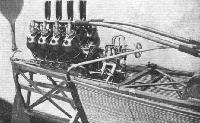 |
Журнал - Flight за 1909 г.
|
PARIS AERO SALON. - View of the Antoinette installation, showing part of the condenser used to convert into water any steam which is formed in the cylinder-jackets.
THE ANTOINETTE FLYER. - View showing an 8-cyl. Antoinette engine installed in the bows of an early flyer. The construction of the main frame and attachment of the condenser are well illustrated, as also is the method of carrying the crank-chamber forward for the support of the propeller.
|
 |
Журнал - Flight за 1909 г.
|
Antoinette Monoplane, showing the triangular elevator and the two triangular rudders in position for turning to the right and for ascending.
THE ANTOINETTE FLYER. - In the above view of the tail the triangular horizontal plane which forms the elevator is shown depressed for descent, while the two triangular rudders are shown set over for turning to the right.
|
 |
Журнал - Flight за 1909 г.
|
| Captain Burgeat's new monoplane "Antoinette VI," with which he has successfully flown at Chalons, is equipped with an interesting under-chassis, which is very well illustrated by the above photograph. In order to keep the machine trimmed while at rest on the ground, a pair of steadying wheels are carried on an outrigger framework. There is also besides the main centre wheel a corresponding wheel jutting out in front, which serves to protect the tractor-screw in the event of the machine landing on the ground nose first.
|
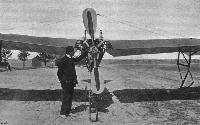 |
Журнал - Flight за 1909 г.
|
| ANTOINETTE MONOPLANE. - View, from behind, showing the propeller and the spring framework and wheels attached to the wings. These serve the double purpose of keeping the machine on the level keel when on the ground, and absorbing any shock when alighting after a flight.
|
 |
Журнал - Flight за 1909 г.
|
| ONE OF THE RACING EPISODES DURING THE RHEIMS AVIATION MEETING. - Farman, on his biplane, giving a good lead to Latham on his Antoinette monoplane.
|
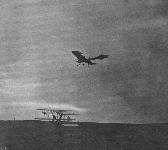 |
Журнал - Flight за 1909 г.
|
| Mr. Hubert Latham in full flight on his Antoinette monoplane on Saturday last at Chalons Camp, when he created a remarkable new record for this type of flyer by remaining in the air for 1h. 7m. 31s., maintaining a speed of about 50 miles per hour. Note the biplane on the ground, the occupants of which are carefully watching Mr. Latham's evolutions.
|
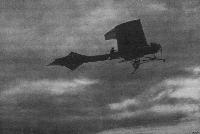 |
Журнал - Flight за 1909 г.
|
| Mr. Hubert Latham flying with his Antoinette monoplane last Saturday at an altitude of about 100 ft., when he put up a new world's record.
|
 |
P.Jarrett - Pioneer Aircraft: Early Aviation Before 1914 /Putnam/
|
| The classic form of the Antoinette monoplanes is represented here by the Antoinette IV, which had conspicious wingtip ailerons, replaced by wing-warping in later models.
|
 |
L.Opdyke - French Aeroplanes Before the Great War /Schiffer/
|
| Another variation. Both still have the long wing skids.
|
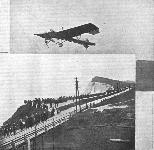 |
Журнал - Flight за 1909 г.
|
| HUBERT LATHAM AND THE CHANNEL FLIGHT. - View on Shakespeare's Cliff at Dover, showing some of the expectant visitors awaiting his arrival. Above, Mr. Latham is seen in full flight on his Antoinette monoplane.
|
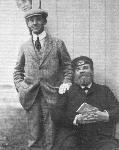 |
Журнал - Flight за 1909 г.
|
| Mr. Hubert Latham (on the left) and M. Levavasseur, the constructor of the Antoinette monoplane with which Mr. Latham has created such wonderful records, at Sangatte.
|
 |
Журнал - Flight за 1909 г.
|
| "ANTOINETTE IV." - The monoplane with which Mr. Hubert Latham contemplates flying the Channel, and with which he has already made such splendid records in France. In this view the entire general construction of the machine is well shown.
|
 |
Jane's All The World Aircraft 1913 /Jane's/
|
| ANTOINETTE IV (1909). In this machine Latham made the first attempt to fly the Channel, 19th July, 1909.
|
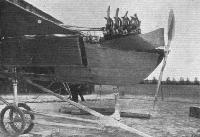 |
Журнал - Flight за 1909 г.
|
| An enlarged view of the front portion of the Antoinette monoplane used by Mr. Hubert Latham, showing the details of construction of the nose, the disposition of the motor, the propellers, and the radiator, and the protecting support underneath the machine attached to the wheels and the lower part of the nose.
|
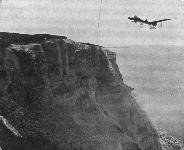 |
Журнал - Flight за 1909 г.
|
| LATHAM'S CHANNEL FLIGHT. - The start from the French coast on Monday morning last.
|
 |
Журнал - Flight за 1909 г.
|
| LATHAM'S CHANNEL FLIGHT. - Hubert Latham and his machine immediately after falling into the sea. It will be noticed that Mr. Latham is standing up in the middle of the flyer, where he was quietly waiting for the French torpedo destroyer "Harpon" to take him on board, in the meantime calmly smoking a cigarette.
|
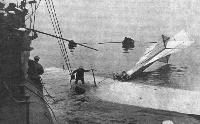 |
Журнал - Flight за 1909 г.
|
LATHAM'S CHANNEL FLIGHT. - The rescue of the Antoinette flyer by the French torpedo destroyer "Harpon." One of the French sailors hitching the hoisting tackle to the centre of the machine.
A watery end to Hubert Latham’s attempt to fly across the Channel in his Antoinette IV on 19 July 1909, 6 days before Bleriot’s successful flight. The Cayley-Henson type ‘kite’ tail unit and the Henson king-posts are clearly visible.
|
 |
Журнал - Flight за 1909 г.
|
| LATHAM'S CHANNEL FLIGHT. - Hubert Latham's return to Calais. The scene after his landing.
|
 |
L.Opdyke - French Aeroplanes Before the Great War /Schiffer/
|
| Demanest 's Antoinette V, still with wing-skids. Note wing cut-outs.
|
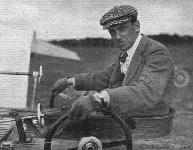 |
Журнал - Flight за 1909 г.
|
| Mr. Hubert Latham at the wheel of his Antoinstte, after accomplishing his remarkable record flight on Saturday.
|
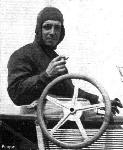 |
Журнал - Flight за 1910 г.
|
| Hubert Latham at the wheel of his Antoinette before his start for his record high flying and trip over Rheims Cathedral during the Aviation Meeting last week.
|
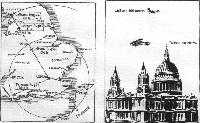 |
Журнал - Flight за 1909 г.
|
| LATHAM AND FARMAN'S RECENT FLIGHTS AT RHEIMS GRAPHICALLY DEPICTED. - What their distance and height achievements are equal to if carried out on familiar ground in England. On the left the single flight of Farman is seen, reaching almost to Weymouth, whilst the three successive flights of Latham placed end on would have brought this remarkable flyer up to Lancaster and Morecambe Bay, beyond Blackpool, where the proposed Aviation Week is to take place next month. On the right the height event is seen, with St. Paul's Cathedral (to scale) as a guide for comparison.
|
 |
Журнал - Flight за 1909 г.
|
| Antoinette
|


























